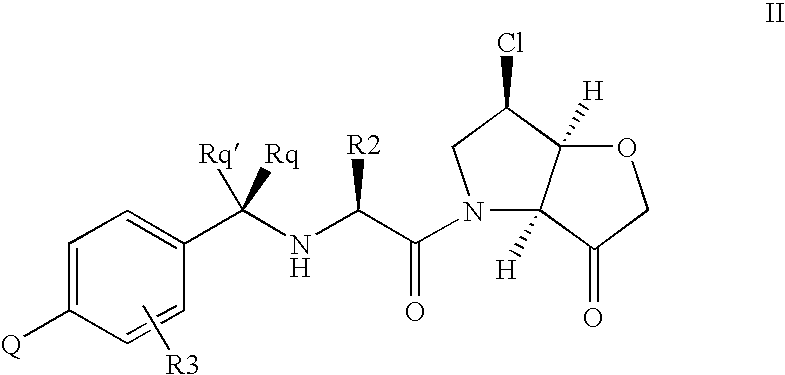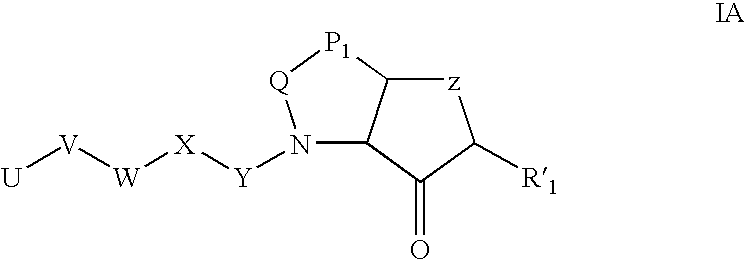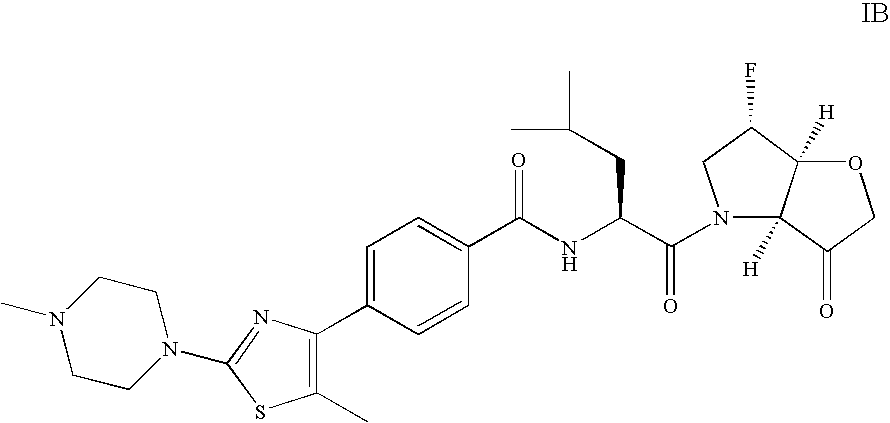Cysteine protease inhibitors
a protease inhibitor and cysteine technology, applied in the direction of biocide, plant growth regulator, animal husbandry, etc., can solve the problems of long half-life, other side effects of bisphosphonates, and inability to remove bisphosphonates from the bon
- Summary
- Abstract
- Description
- Claims
- Application Information
AI Technical Summary
Benefits of technology
Problems solved by technology
Method used
Image
Examples
example 1
Preparation of P1 Building Block
Step a)
[0152]
[0153]1 (7.0 g, 28.5 mmol) (3-azido-3-deoxy-1,2-O-(1-methylethylidene)-α-D-allofuranose prepared as described in Tronchet, Jean M. J.; Gentile, Bernard; Ojha-Poncet, Joelle; Moret, Gilles; Schwarzenbach, Dominique; Barbalat-Rey, Francoise; Tronchet, Jeannine. Carbohydrate Research (1977), 59(1), 87-93) was dissolved in dry pyridine (50 mL) and the solution cooled to 0° C. Mesyl chloride was slowly added to the solution and the solution allowed to warm upto room temperature. The reaction was stirred overnight and after 14 hrs MeOH (10 mL) was added followed by EtOAc (150 mL). The solution was washed three times with 2 M H2SO4 (aq) (3×100 mL) and two times with NaHCO3 sat.(aq) (2×100 mL) and thereafter the organic phase was dried with Na2SO4, filtered and concentrated in vacuo. After the product was put on a high vacuum pump overnight to remove residual solvents, product 2 was obtained as a pale yellow oil in quantitative yield (11.5 g).
[01...
example 2
P-2 Coupling with L-Leu
[0186]
[0187]DIEA (304 μL, 1.84 mmol) and BOC-Leu (117 mg, 0.506 mmol) was added to crude 13 (112 mg, 0.460 mmol), dissolved in DMF (6 mL). The reaction flask was cooled in an ice bath for 10 minutes before addition of HATU (193 mg, 0.506 mmol). The reaction was stirred for 3 hours at room temperature before concentration in vacuo. The crude residue was dissolved in CHCl3 (15 mL) and washed with 10% citric acid (aq) (10 mL) and NaHCO3 (sat, aq) (10 mL). The organic phase was dried with Na2SO4, filtered and evaporated. The crude product was purified by flash chromatography (Heptane:Ethyl:acetate (2:1->1:1) to give product 14 in a yield of 62% (121 mg).
example 3
P3 Building Block
4-[5-methyl-2-(4-methyl-piperazin-1-yl)-thiazol-4-yl]benzoic acid
[0188]
Step a) 4-Cyanopropiophenone
[0189]
[0190]As described for the preparation of 4-cyanoacetophenone (Synth. Commun 1994, 887-890), a mixture of 4-bromopropiophenone (5.65 g, 26.4 mmol), Zn(CN)2 (1.80 g, 15.3 mmol), and Pd(PPh3)4 (2.95 g, 2.6 mmol) was refluxed at 80° C. in deoxygenated DMF (35 mL, stored over 4 Å molecular sieves, bubbled with Ar before use) for 18 h. The mixture was partitioned between toluene (100 mL) and 2N NH4OH (100 mL). The organic phase was extracted with 2N NH4OH (100 mL), washed with saturated aqueous NaCl (2×100 mL), dried, and concentrated in vacuo. A 10 mmol scale reaction was done similarly and the crude products were combined. Flash chromatography (330 g silica, 6 / 1 petroleum ether—EtOAc) afforded the desired compound as a white solid (5.17 g, 89%).
[0191]1H NMR (CDCl3) δ ppm: 1.22 (t, 3H, J=7.2 Hz), 3.00 (q, 2H, J=7.3 Hz), 7.75 (d, 2H, J=8.8 Hz), 8.03 (d, 2H, J=8.4 Hz)
[...
PUM
| Property | Measurement | Unit |
|---|---|---|
| temperature | aaaaa | aaaaa |
| temperature | aaaaa | aaaaa |
| temperature | aaaaa | aaaaa |
Abstract
Description
Claims
Application Information
 Login to View More
Login to View More - R&D
- Intellectual Property
- Life Sciences
- Materials
- Tech Scout
- Unparalleled Data Quality
- Higher Quality Content
- 60% Fewer Hallucinations
Browse by: Latest US Patents, China's latest patents, Technical Efficacy Thesaurus, Application Domain, Technology Topic, Popular Technical Reports.
© 2025 PatSnap. All rights reserved.Legal|Privacy policy|Modern Slavery Act Transparency Statement|Sitemap|About US| Contact US: help@patsnap.com



